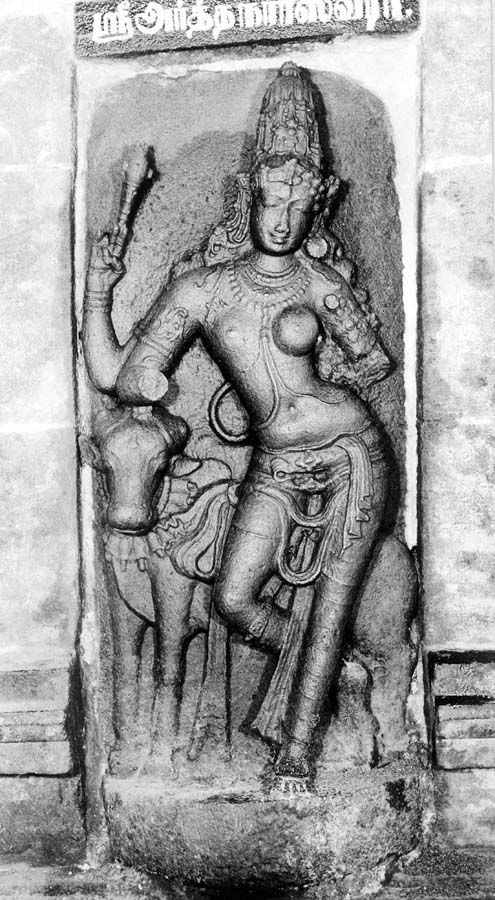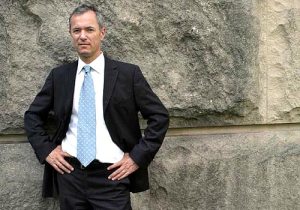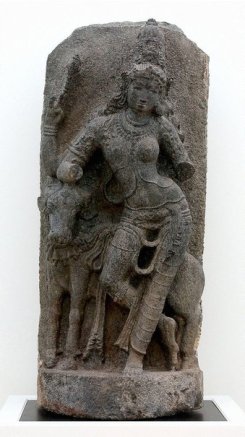A 900-year-old Indian statue at Sydney’s Art Gallery of New South Wales was stolen from an Indian temple sometime after 1974, newly identified images show.
Last week, the Art Gallery NSW released provenance records for the Chola-era sculpture of Ardhanarishvara which it purchased in 2004 for more than $300,000. The documents were supplied by Subhash Kapoor, the prominent Manhattan antiquities dealer who sold the sculpture to the museum. (Previous Kapoor coverage here.) The records claim a New York antiquities collector had purchased the sculpture in 1970 from a handicraft dealer in Dehli and held it ever since.
Today we can say that ownership history, like others supplied by Kapoor, was fabricated. Images identified by Poetry in Stone, a blog that celebrates South Asian temple sculpture, show the statue was in situ at the Vriddhachalam temple in Tamil Nadu, India for at least four years after 1970 and was subsequently stolen.
The image above left shows the sculpture in Sydney as it looks today. The image above right was published in Douglas Barrett’s 1974 book Early Chola Architecture and Sculpture 866 – 1014 and shows the sculpture in its original context at the Vriddhachalam temple.
How the identification was made
The discovery of the sculpture’s origin is a result of rapid international collaboration. After requests from Jason and The Australian’s Michaela Boland, the Art Gallery NSA released the Kapoor provenance documents on June 25. On June 28th, A. Srivathsan at The Hindu wrote a story about the recent Kapoor revelations with a link to ChasingAphrodite.com

One of the people who read the story was Vijay Kumar, the creator of Poetry in Stone. Kumar came to this site, saw our post on the Ardhanarishvara and recognized it immediately.
Four years earlier, Kumar had published an iconographic study of Ardhanarishvara, the androgynous manifestation of the Hindu god Shiva and his lover Parvati. One of the temple sculptures he singled out as the “perfect form” of the god was in the Vriddhachalam temple:
You can see the female portion in full triple flexion ( tribanga) and to compensate for it, the right leg of Shiva is bent fully. This causes the male torso to lean at the awkward angle and though the sculpture would look pleasing it would not be aesthetically appealing. So he comes up with an ingenious solution. Make Shiva rest or lean on to something and the readily available option is his mount or vehicle – Nandhi. Presto, problem solved. Add lots of beautiful ornamentation, develop the differences in the dressing style and this perfected model becomes a standard for all Ardhanari images henceforth.
When Kumar recognized the Sydney sculpture as the very same “perfect model,” he dug through his files and found the 1974 plate in the Barrett book and other records of the statue, which was well documented in its original context. Here is an image of the statue in situ with a Tamil inscription above the niche from the archives of the American Academy of Benares, Varanasi:
 In an email to me today, Kumar wrote:
In an email to me today, Kumar wrote:
“This particular form was my personal favorite as its beauty appealed to me in a queer form: despite two of the main limbs, the hands mutilated, the sculpture still retained its sinuous grace. If you were to look at an ordinary piece of art with such a deformity your eye would instantly go to the broken parts. However, in this piece unless someone specifically points it out to you, at first glance you tend to miss the broken hands! Apart from that, the brilliant ornamentation and their swaying etc. are wonderfully sculpted. The ear of the bull comes a bit out of the composition as well. Overall the contours of the kosta block itself are unique as well and offer the vital clue.”
Coincidently, Kumar is a native of Chennai, the Tamil Nadu capital where Kapoor is currently facing trial. He currently lives in Singapore but has reached out to contacts in Tamil Nadu to determine when and how the sculpture was stolen from the Vriddhachalam temple. We’ll keep you posted on what he finds out.

Michael Brand
Meanwhile, the revelations raise several questions. When will other museums release provenance information provided by Kapoor? If the Art Gallery NSW sculpture had been so widely published, why did the museum not identify it as stolen before the 2004 acquisition? And how will the museum’s director Michael Brand respond to compelling new evidence that objects acquired before his arrival in Sydney were apparently stolen and smuggled out of India.
Brand, whose specialty is South Asia art, faced similar questions at the Getty Museum and did the right thing.
Will he now?




